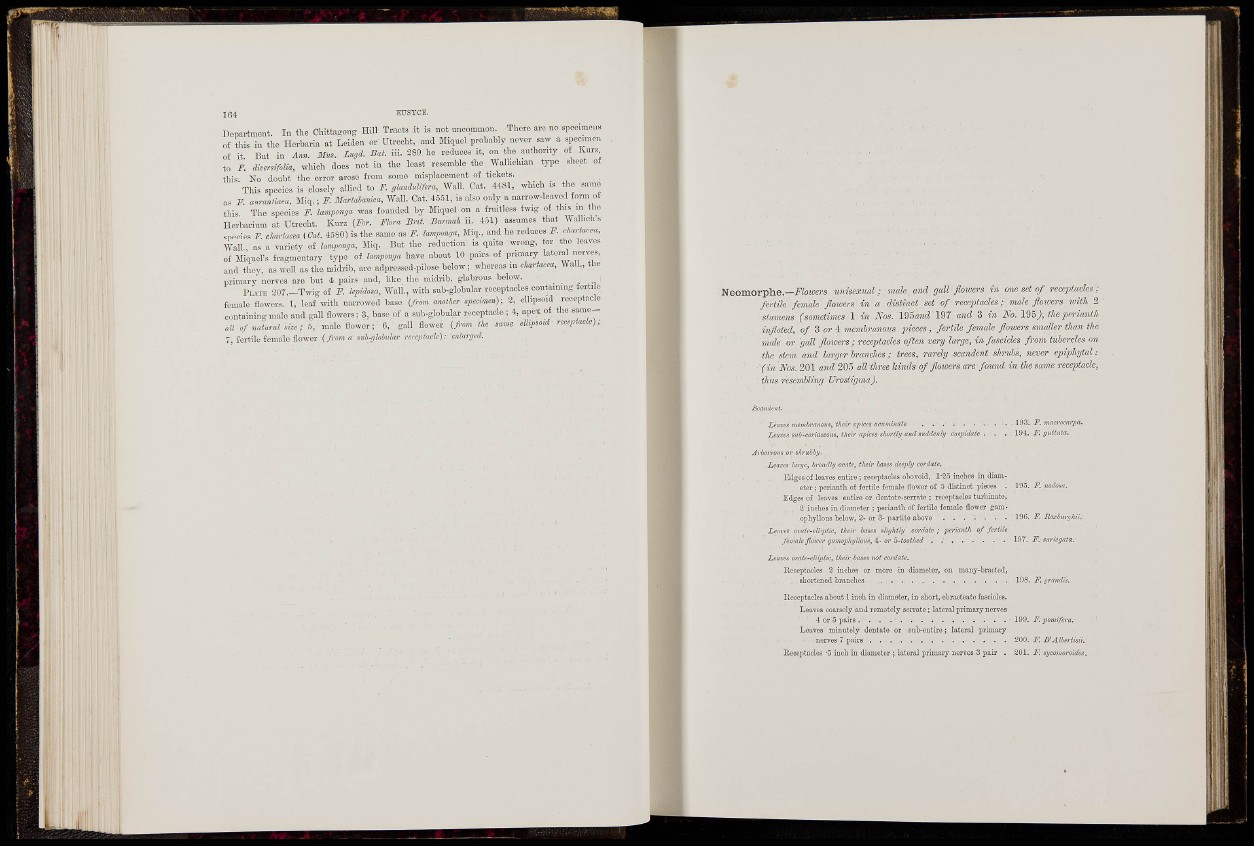
I (34 EUSXCE.
Department. In the Chitta-ong Hill Tracts it is not uncommon. There are no specimens
of this i» the Herbaria at Leiden or Utrecht, and Miquel probably nover saw a specimen
of it. But in Mus. Lugd. Bat. iii. 289 he reduces it, on the authority o Kur.
to F. dmrsifolia, which does not in the least resemble the Wallichian type sheet of
this No doubt the error arose from some misplacement of tickets.
This species is closely allied to F. glandulifcra, Wall. Cat. 4481, which is the same
ns F uuranliaca, Miq.; F. Martahanica, Wall. Cat. 4551, is also only a narrow-leaved form ot
this. The species F. lamponga was foanded by Miquel on a fnütles. twig of this in the
Herbarium at Utrecht. Kurz {For. Flora Bnt. Burmah ii. 451) assumes that Wdbch s
.pecies F chartaeea {Cat. 4580) is the same as F. lamponga, Miq., and ho reduces F. chartacea,
W l . , as a variety of lamponga, Miq. But the reduction is quite wrong, for the leaves
of Miquel's fragmentary type of lamponga have about 10 pairs of primary lateral nerves,
and they, as well as the midrib, are adpressed-pilose below; whereas in chartacea, Wall., tlie
primary nerves are but 4 pairs and, like the midi-ib, glabrous below. _ _ _
PWTE 207. -Twi g of F. lepidosa, Wall., with sub-globular receptacles containing terti o
female flowers. 1, leaf with narrowed base {from another spccmen)-, 2, ellipsoid receptacle
containing male and gall flowers; 3, base of a sub-globular receptacle; 4, apex o£ the same
all of natural size; b, male flower; 6, gall flower {frovi the same ellipsoid receptacle);
7, fertile female flower {from a snh-(jlohilar receptacle): enlarged.
Neomorphe.—i^/oíüers unisexual; male and (jail floiuers in one set of receptacles;
fertile female flowers in a. distinct set of receptacles; male flowers with 2
stamens (sometimes 1 in Nos. 195 ancZ 197 and 3 in No. 19 5j, tliepp-rianih
inflated, of Z or Í memlranous pieces, fertile female flowers smaller than the
male or gall flowers; receptacles often very large, in fascicles from tubercles on
the stem and larger branches; trees, rarely scandent shrubs, never epiphytal:
(in Nos. 201 and 205 all three kinds of flowers are found in the same receptacle,
thus resemUing Urostigma).
Leaves membranous, their cpices aciumnate ^
Leaves sub-coriaceous, their apices shortly and suddenli/ cuspidata .
Arboreous or shrMy.
Leaves large, broadly ovate, their loses dee})ly cordate.
Edgesof leaves entire; receptacles oTjovoid. 1'25 inctes in diam
eter ; perianth of fertile female flower of 5 distinct pieces
Edges of leaves entire or dent ate-serrate ; receptacles turbinate
2 inches in diameter ; perianth of fertile feraale flower gam
ophyllons below, 2- or 3- partite above . . . . .
Leuven omte-eiUptio, their bases dighilij cordate; perianth of fertile
us, 4- or 5-toothed .
. 193. F. macroearpa.
194. F. ffuttata.
196. F. Roxburohii.
Leaven omte-ellipitic, their bases not cordate.
lleceptacles 2 iuchos or more iii diameter, (
eborteued bra aches
many-bracted,
198. F. írandií.
Eeceptacles about 1 inch in diameter, in short, obracteate fascicles.
Leaves ooarsely and remotely sei-rate; lateral primary nerves
4 or 5 pairs 199. F. pomífera.
Leaves minutely deutate or sub-entire; lateral primary
nerves 7 pairs 200. F. D''Albertisii.
Eeceptacles '5 inch in diameter ; lateral primary nerves 3 pair . 201. F. s,